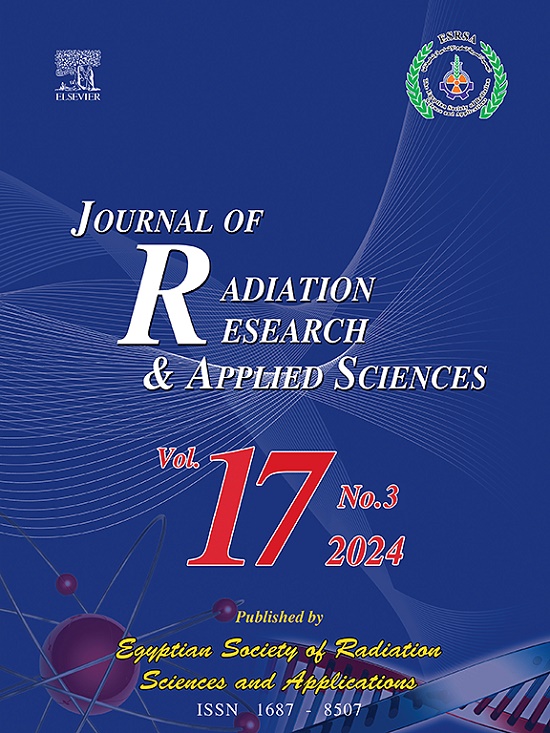Impact of calcium content on optical properties and radiation shielding performance of lithium antimony borate glasses
IF 1.7
4区 综合性期刊
Q2 MULTIDISCIPLINARY SCIENCES
Journal of Radiation Research and Applied Sciences
Pub Date : 2024-09-23
DOI:10.1016/j.jrras.2024.101124
引用次数: 0
Abstract
This paper investigates the influence of calcium doping on optical properties and radiation shielding of lithium antimony borate glasses described by xCaO:10Li2O: (70-x)B2O3: 20Sb2O3, with x = 0, 5, and 10 mol% with codes of CLSB1, CLSB2, and CLSB3, respectively. The optical parameters and factors of these borate glasses are determined based on the value of the refractive index. In addition, FLUKA is used to simulate the behavior of radiation in a wide range of shielding scenarios, and optimize the design of radiation shielding systems for the borate glasses involved. The obtained reflection loss Rloss and Optical transmission Topt in this study displayed an inverse relationship to each other as the molar fraction of CaO increases in the CLBSx glass system. The computed values for MAC and LAC varied from 0.21696 to 0.05357 cm2g-1 and 0.73333 to 0.18107 cm−1 for CLSB1, 0.21789 to 0.05360 cm2g-1 and 0.78660 to 0.19348 cm−1 for CLSB2, 0.21884 to 0.05362 cm2g-1 and 0.82502 to 0.20214 cm−1 for CLSB3. The obtained findings reveal that the developed glass system under this study competes favorably with the commercial glasses. For example, CLSB1, CLSB2, and CLSB3 display superior shielding characteristics to RS 323 G19,RS 360 and RS 520 at the photon energy 0.2 MeV except R 253 and RS 323 G19 at energy MeV and to all the commercial glasses at energies 0.662 (137Cs) and 1.25 (60Co) MeV.
钙含量对硼酸锑锂玻璃光学特性和辐射屏蔽性能的影响
本文研究了钙掺杂对 xCaO:10Li2O: (70-x)B2O3: 20Sb2O3 所描述的硼酸锑锂玻璃的光学特性和辐射屏蔽的影响,x = 0、5 和 10 mol%,代码分别为 CLSB1、CLSB2 和 CLSB3。这些硼酸盐玻璃的光学参数和系数是根据折射率值确定的。此外,FLUKA 还用于模拟各种屏蔽情况下的辐射行为,并优化相关硼酸盐玻璃的辐射屏蔽系统设计。本研究中获得的反射损耗 Rloss 和光学透射率 Topt 随着 CLBSx 玻璃系统中 CaO 摩尔分数的增加而呈现出反比关系。研究结果表明,本研究中开发的玻璃系统可与商用玻璃相媲美。例如,在光子能量为 0.2 MeV 时,CLSB1、CLSB2 和 CLSB3 的屏蔽特性优于 RS 323 G19、RS 360 和 RS 520(能量为 MeV 的 R 253 和 RS 323 G19 除外);在能量为 0.662(137Cs)和 1.25(60Co)MeV 时,CLSB1、CLSB2 和 CLSB3 的屏蔽特性优于所有商用玻璃。
本文章由计算机程序翻译,如有差异,请以英文原文为准。
求助全文
约1分钟内获得全文
求助全文
来源期刊

Journal of Radiation Research and Applied Sciences
MULTIDISCIPLINARY SCIENCES-
自引率
5.90%
发文量
130
审稿时长
16 weeks
期刊介绍:
Journal of Radiation Research and Applied Sciences provides a high quality medium for the publication of substantial, original and scientific and technological papers on the development and applications of nuclear, radiation and isotopes in biology, medicine, drugs, biochemistry, microbiology, agriculture, entomology, food technology, chemistry, physics, solid states, engineering, environmental and applied sciences.
 求助内容:
求助内容: 应助结果提醒方式:
应助结果提醒方式:


